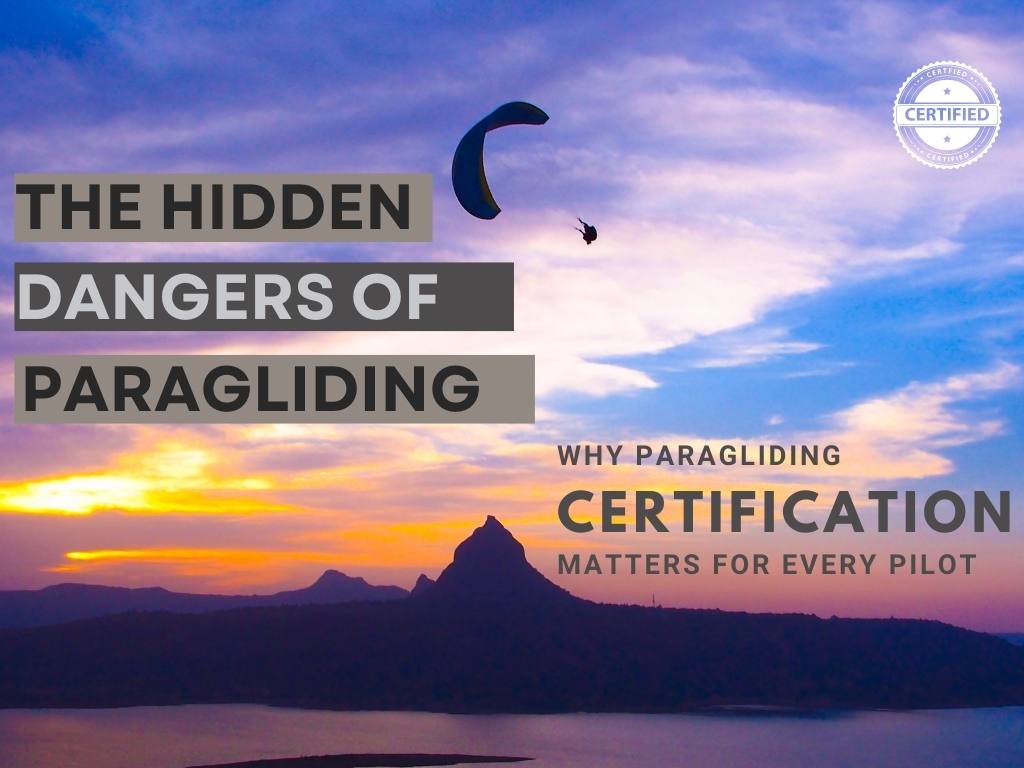Paragliding is an exhilarating adventure sport that offers the thrill of soaring through the skies, but it also comes with inherent risks. The complexity of flying, coupled with unpredictable weather conditions, means that adequate training is not just beneficial—it’s essential. Relying on uncertified trainers can seem like a cost-saving option, but it can lead to inadequate preparation and potentially dangerous situations. Investing in proper certification and training from recognized instructors ensures you not only learn vital safety protocols and techniques but also develop the skills necessary for a safe and enjoyable flying experience. Remember, the right training is an investment in your safety and long-term success as a pilot.
Paragliding certification is more than just a license; it’s a testament to a pilot’s skill, experience, and dedication to safety in this high-risk adventure sport. Paragliding certification offers several benefits, both for personal safety and for advancing your skills. Here are some of the main advantages:
1. Structured Training and Skill Development
Certification provides a structured pathway to learning, using tools such as theory classes, video sessions, and exams. Each certification level covers a comprehensive syllabus, including equipment knowledge, weather assessment, mental preparedness, and advanced flying techniques. This structured approach ensures that you progress methodically and safely, mastering each aspect of the sport under expert guidance.
2. Safety Assurance
- Training & Knowledge: Certified courses teach you the technical skills, safety protocols, and emergency procedures necessary to handle various flying conditions.
- Instructor Guidance: You learn under the guidance of experienced instructors who can correct mistakes and help you build confidence.
3. Safety and Risk Management
Paragliding, like any adventure sport, comes with inherent risks and dangers. Certification is designed to mitigate these risks through rigorous training standards established by experts with years of experience. Proper training and certification ensure that pilots understand safety protocols, can handle emergency situations, and fly responsibly. Only the right training will keep you safe in the air.
4. Recognition and Access
Although there is no centralized legal framework governing paragliding in some countries, local associations and flying sites often have their own regulations. While not all sites require certification, having one, whether from APPI, BHPA, USHPA, or any other recognized body, demonstrates your competence and seriousness as a pilot. This can be crucial for gaining access to popular sites where safety is a priority, and independent amateur pilots are generally not welcome.
5. Logbooks and Skill Validation
Certification is not just about completing a course; it also involves maintaining a logbook of your flights and tasks, signed off by certified instructors. This documented experience is a tangible way to showcase your skill level and flying history. It builds your credibility within the paragliding community, allowing you to participate in advanced courses, competitions, and events.
6. Global Standards and Community
Certifications from recognized bodies adhere to international standards, enabling you to fly in different parts of the world where such qualifications are required. Being part of a global community also opens up opportunities to learn from other pilots, exchange experiences, and stay updated on the latest advancements in the sport.
7. Access to Equipment and Sites
- Rental and Purchase: Many paragliding equipment rental shops and sellers require certification before they rent or sell gear to ensure that you know how to use it safely.
- Flying Sites: Some flying sites, especially in regulated areas, require pilots to show certification to access the launch areas.
8. Insurance Benefits
- Liability and Accident Insurance: Some insurance companies provide coverage only to certified pilots, which can be crucial in case of accidents or damage.
9. Global Recognition
- International Permits: Certification from recognized bodies (e.g., APPI, USHPA, BHPA) is often required to fly in other countries, making it easier to explore new locations legally and safely.
10. Skill Development
- Structured Learning Path: Certification involves different levels, each building on the previous one, ensuring a structured and comprehensive learning process.
- Advanced Techniques: You can learn advanced techniques, such as cross-country flying, acrobatics, and thermalling, under expert supervision.
11. Community and Networking
- Clubs and Events: Certified pilots can join paragliding clubs, participate in events, competitions, and trips, which helps in building a network and gaining new experiences.
- Mentorship Opportunities: You can mentor new pilots, sharing your skills and experiences once you achieve advanced certification.
12. Confidence and Personal Achievement
- Confidence in Skills: Certification gives you confidence in your abilities, making flying more enjoyable.
- Achievement Recognition: Completing certification is a milestone, giving you a sense of accomplishment and recognition in the paragliding community.
- Professional Opportunities
- Instructor Roles: With advanced certification levels, you can become a certified paragliding instructor, teaching and mentoring new pilots.
- Tandem Pilot: Certification can also qualify you to become a tandem pilot, taking passengers on flights, which can be a fulfilling and profitable career.
In summary, paragliding certification is a crucial step for anyone serious about the sport. It offers a structured training approach, enhances safety, provides recognition, and ensures that you are well-equipped to handle the challenges of flying. While there may not be official laws in every country, the importance of certification is acknowledged across the community, making it a vital aspect of becoming a skilled and responsible pilot. Overall, paragliding certification is an investment in safety, skill enhancement, and broader opportunities within the sport.
